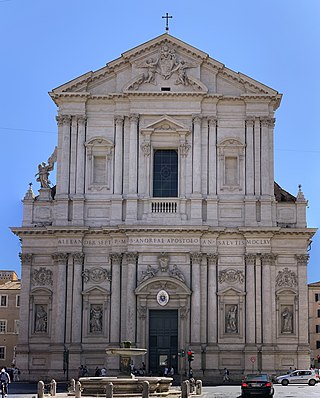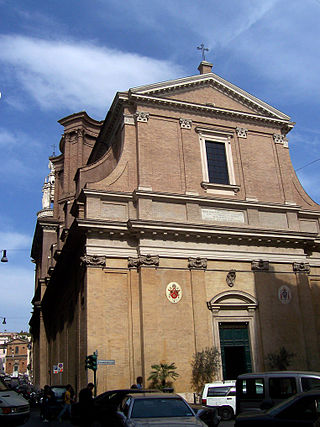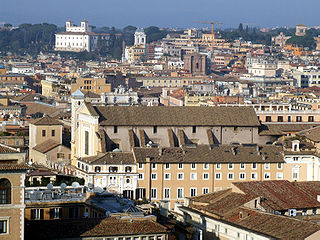
Benozzo Gozzoli was an Italian Renaissance painter from Florence. A pupil of Fra Angelico, Gozzoli is best known for a series of murals in the Magi Chapel of the Palazzo Medici-Riccardi, depicting festive, vibrant processions with fine attention to detail and a pronounced International Gothic influence. The chapel's fresco cycle reveals a new Renaissance interest in nature with its realistic depiction of landscapes and vivid human portraits. Gozzoli is considered one of the most prolific fresco painters of his generation. While he was mainly active in Tuscany, he also worked in Umbria and Rome.

Sant'Andrea della Valle is a minor basilica in the rione of Sant'Eustachio of the city of Rome, Italy. The basilica is the general seat for the religious order of the Theatines. It is located at Piazza Vidoni, at the intersection of Corso Vittorio Emanuele and Corso Rinascimento.

The Basilica of Saint Francis of Assisi is the mother church of the Roman Catholic Order of Friars Minor Conventual in Assisi, a town in the Umbria region in central Italy, where Saint Francis was born and died. It is a papal minor basilica and one of the most important places of Christian pilgrimage in Italy. With its accompanying friary, Sacro Convento, the basilica is a distinctive landmark to those approaching Assisi. It has been a UNESCO World Heritage Site since 2000.

The Parish Basilica of Santa Maria del Popolo is a titular church and a minor basilica in Rome run by the Augustinian order. It stands on the north side of Piazza del Popolo, one of the most famous squares in the city. The church is hemmed in between the Pincian Hill and Porta del Popolo, one of the gates in the Aurelian Wall as well as the starting point of Via Flaminia, the most important route from the north. Its location made the basilica the first church for the majority of travellers entering the city. The church contains works by several famous artists, such as Raphael, Gian Lorenzo Bernini, Caravaggio, Alessandro Algardi, Pinturicchio, Andrea Bregno, Guillaume de Marcillat and Donato Bramante.

The Madonna of Loreto or Pilgrim's Madonna is a painting (1604–1606) by the Italian Baroque master Caravaggio, located in the Cavalletti Chapel of the church of Sant'Agostino, just northeast of the Piazza Navona in Rome. It depicts the barefoot Virgin holding her naked child in a doorway before two kneeling peasants on a pilgrimage.

San Marcello al Corso, a church in Rome, Italy, is a cardinalitial titular church whose cardinal-protector is normally of the order of cardinal priests.

The Cerasi Chapel or Chapel of the Assumption is one of the side chapels in the left transept of the Basilica of Santa Maria del Popolo in Rome. It contains significant paintings by Michelangelo Merisi da Caravaggio and Annibale Carracci, two of the most important masters of Italian Baroque art, dating from 1600 to 1601.

The Minor Basilica of St. Lawrence in Damaso or simply San Lorenzo in Damaso is a parish and titular church in central Rome, Italy that is dedicated to St. Lawrence, deacon and martyr. It is incorporated into the Palazzo della Cancelleria, which enjoys the extraterritoriality of the Holy See.

Sant'Andrea delle Fratte is a 17th-century basilica church in Rome, Italy, dedicated to St. Andrew. The Cardinal Priest of the Titulus S. Andreae Apostoli de Hortis is Ennio Antonelli.

Our Lady of Good Counsel is a title given to the Blessed Virgin Mary, after a painting said to be miraculous, now found in the thirteenth century Augustinian church at Genazzano, near Rome, Italy. Measuring 40 to 45 centimetres the image is a fresco executed on a thin layer of plaster no thicker than an egg shell. Over the centuries, devotions to Our Lady of the Good Counsel grew among saints and Popes, to the extent that a reference to it was added to the Litany of Loreto and the devotion spread throughout the world. Her feast day is 26 April.

San Silvestro al Quirinale is a historic church in central Rome, Italy. It is located near Via XXIV Maggio corner with Via Mazzarino, a few blocks south of the Piazza del Quirinale.

San Nicola da Tolentino agli Orti Sallustiani is a church in Rome. It is referred to in both Melchiori's and Venuti's guides as San Niccolò di Tolentino, and in the latter it adds the suffix a Capo le Case. It is one of the two Roman national churches of Armenia. The church was built for the Discalced Augustinians in 1599, and originally dedicated to the 13th century Augustinian friar Saint Nicholas of Tolentino.

The Basilica of Saint Nicholas of Tolentino is a Roman Catholic church and minor basilica that is part of the Augustinian monastery in the hill-town of Tolentino, province of Macerata, Marche, central Italy. The church is a former cathedral of the Roman Catholic Diocese of Tolentino, suppressed in 1586.

The Prophet Isaiah is a fresco located in Basilica di Sant'Agostino, an early Renaissance church in Rome. It is an Italian Renaissance painting, influenced by Michelangelo's work on the Sistine Chapel ceiling.

The Church of Saint Lucy in Selci is an ancient Roman Catholic church, located in Rome, dedicated to Saint Lucy, a 4th-century virgin and martyr.

Jacopo Zoboli was an Italian painter.

The Basilica of Santa Aurea is a church situated in the Ostia Antica district of Ostia, Italy. Ostia became an episcopal see as early as the 3rd century AD. The present-day church, completed in 1483, is the cathedral of the suburbicarian diocese of Ostia.

Santi Dodici Apostoli, commonly known simply as Santi Apostoli, is a 6th-century Roman Catholic parish and titular church and minor basilica in Rome, Italy, dedicated originally to St. James and St. Philip, whose remains are kept here, and later to all Apostles. Today, the basilica is under the care of the Conventual Franciscans, whose headquarters in Rome is in the adjacent building. It is the Station church for Friday, the first week of Lent.

The Basso Della Rovere or Saint Augustine Chapel is located in the south aisle of the basilica of Santa Maria del Popolo in Rome. This is the third side chapel from the counterfaçade and was dedicated to St. Augustine. The cycle of beautiful quattrocento frescoes was executed by Pinturicchio and his workshop.

San Trifone in Posterula was an ancient titular church of Rome, now lost. It was located at the corner of Via dei Portoghesi and Via della Scrofa, in the Campo Marzio rione of the city.




































